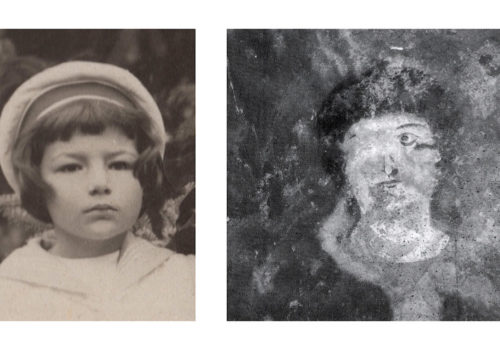The TSAVT TANEM exhibition by the artist Camille Levêque is presented at the Hauts-de-France Regional Center for Photography in Douchy-les-Mines, first meeting in the programming of the new director Audrey Hoareau who answered questions from The Eye of Photography.
1. What did you find interesting to show by inviting photographer Camille Lévêque for this exhibition?
Camille Bishop’s choice meets several desires. That of offering a unique photographic writing, Camille is a visual artist who fully explores the medium by offering to play different media. And then it’s an approach, almost a quest, which resonates with a lot of current debates. The construction of identity is at the heart of her work. From her Armenian origins, she raises questions that we can all ask ourselves, especially young audiences. It is not a project on Armenia but on the family, the inheritance, the transmission, how one struggles with all this to come to know who one is. introspection is capital, it is a confrontation between the image of a fantasized country nourished by family stories and the image that one creates for oneself.
This exhibition will be the first of my program and it is a signal, a commitment. The CRP / honors a French artist and produces her entire new series. We are really committed to supporting and accompanying artists by producing new works.
2. Her work revolves around family memory, identity and the bridge between cultures. Did this intimate dimension particularly touch you?
It is a recurrence in her work that shows great consistency. For example, we are working in parallel to the exhibition with Camille on the publication of her next book, the fruit of five years of work on the father figure. In search of the father, like Tsavt Tanem, compiles layers of images with very different statuses. These two series also have the common point of dealing with fundamental subjects around family patterns and the power of representations. In my opinion, the power of certain artists lies in this ability to touch us deeply when their work deals with the private sphere or an intimate situation. The echo produced impresses me.
3. Born in 1985, Camille Lévêque is a photographer in her thirties and a representative of a new form of photographic writing, perhaps a little more open to the inner questions of youth and visibly concerned about the complexity of the world, especially the place of women and the role of patriarchy in history. Are you particularly keen to present the work of this generation in the CRP /?
Camille Lévêque has already made good progress in her career. I have followed her career and her evolution interests me, but I also think of supporting emerging artists for whom this would be the first exhibition, and, conversely, more experienced photographers. Beyond the generational aspect, I am more guided by the originality of the approaches and the substance of the subject. The commitment, what the artist wants to convey to us, is really what matters. At the CRP / there is a whole program of educational and cultural actions that we build on the basis of the exhibition, it is also decisive to keep that in mind when designing the programming.
Camille’s approach makes sense today because it effectively calls into question the weight of patriarchy among others. We need artists to shake up the old system, it’s up to us to give them the best possible expression.
4. More generally, what type of photographs do you wish to defend at the CRP /?
In May we will present a group exhibition that will feature four emerging Chinese artists. As the CRP / defines itself as a place of discovery and experimentation, it is important to come up with projects that may at first seem very remote to us, but which ultimately resemble us. The Chinese photography scene is daring and this proposal will bring together high quality projects dealing with sensitive subjects. In the fall we will be celebrating the 40th anniversary of the CRP /. This anniversary will be an opportunity to promote the collection and tell our story. These are the artists who made the center what it is. We will pay tribute to them through a multi-site exhibition. Finally, the year will end with a resumption of the exhibition currently on view at Centquatre-Paris, Everything must disappear, From the collection of vernacular photographs of Jean-Marie Donat. It talks about the consumer society, our commodity-based system.
Going through the year 2022 quickly, we can feel how plural the photography we are defending is. At the CRP / our lines of research are particularly oriented around the political role of photography in the broad sense and the questioning of our relationship to the image.
5. What other projects are planned for the place?
Several major projects are underway. In-depth work on the collections, in particular with a publication project. For the first time, thinking about an editorial project that would be a date and a reference. And especially the CRP / extension project! As we expand (at this point we are talking about tripling our surface area), the centre’s ambitions for the future will need to be reassessed.
Interview by Jean-Baptiste Gauvin
TSAVT TANEM
January 15 – April 24, 2022
CRP / Hauts-de-France
Pl. Des Nations, 59282 Douchy-les-Mines
















